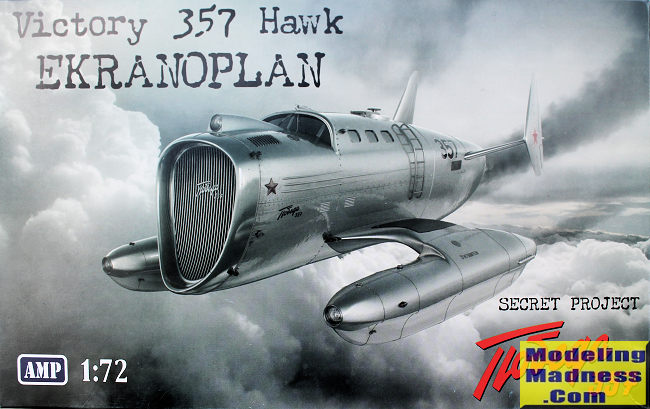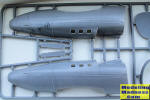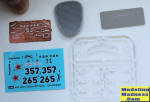
AMP 1/72 Victory 357 Hawk
| KIT #: | 72010 |
| PRICE: | AUD$61.99 |
| DECALS: | Two options |
| REVIEWER: | George Oh |
| NOTES: | A Russian speculative Supermegafugly antigrav secret project. |

| HISTORY |
(from the kit instructions).
In 1929, Thomas T. Brown published an article in the prestigious 'Science and Invention Magazine'. The articled title was simple - "How I Control Gravity." - in-which he claimed that he could so by using 'electrogravitics'. He placed a Coolidge X-ray vacuum tube on a balance scale. When the tube's positive electrode was pointed upwards, its mass seemed to decrease. When it was pointed downwards, its mass seemed to increase. He elaborated that, with a sufficiently-powerful engine generating enough voltage, any object could be rendered weightless.
This caught the attention of the Americans and Russians. After WWII, the Russians established a special sector under the Institute for Physical Problems. The sector became independent as the Gravity Control Propulsion Research Centre. It conducted large-scale experiments and showed that a 500kg block of solid graphite didn't weigh its normal 4903N(ewtons), but 3236N.
The next step was to do the same thing outside of a laboratory. So, the Victory 357 was developed. It was basically an Ekranoplan with three small jet engines for horizontal propulsion, and a huge 15,500 HP Kuznetsov NK-12 generator that provided enough electricity to the electrogravitic elements to reduce the vehicle's weight from 160,000N/16315kg down to 85,000N/8667kg. The Victory 357 proved the technology and was quite nimble, but it has little space for crew, cargo or payload.
| THE KIT |
 This is a superbly-moulded kit
with absolutely no flash, sink-marks or inconveniently-placed knockout-pin
scars. There are 54 parts on 4 sprues, 1 already cleaned-up resin part (the
front grill), 16 clear parts, a fret with 8 PE parts (including the IP), a sheet
of 12 masks and a sheet of 11 minor and an IP decal. As this is a one-off
concept, there are no options in the construction process. External details are
of both the raised and engraved type.
This is a superbly-moulded kit
with absolutely no flash, sink-marks or inconveniently-placed knockout-pin
scars. There are 54 parts on 4 sprues, 1 already cleaned-up resin part (the
front grill), 16 clear parts, a fret with 8 PE parts (including the IP), a sheet
of 12 masks and a sheet of 11 minor and an IP decal. As this is a one-off
concept, there are no options in the construction process. External details are
of both the raised and engraved type.
The cockpit is completely
appointed (two seats, sticks and control wheels), but lacks minute detail. The
rear compartment has only two rather-Spartan bench seats. This is probably OK,
because not much will be visible through the small clear bits as there will be
little light inside. Together they occupy the centre third of the body of the
craft. This leaves the model with plenty of room inside, should the builder
elect to light the model.
as there will be
little light inside. Together they occupy the centre third of the body of the
craft. This leaves the model with plenty of room inside, should the builder
elect to light the model.
The instructions are on two A3 sheets forming eight A4 sides. They are quite detailed with a page each for the 'history', parts diagrams and paint & decaling instructions. This leaves 5 sides that shows 14 assembly steps.
| CONCLUSIONS |
I just HAD to have this because it is such an ugly beast. And because it is a speculative machine, in a Competition, should it be entered as a 'Whatiffer', or under Sci-Fi?
Thanks t If you would like your product reviewed fairly and fairly quickly, please contact the editor or see other details in the
Note to
Contributors.